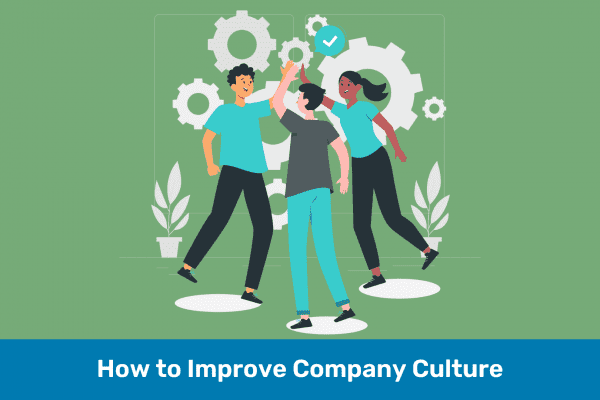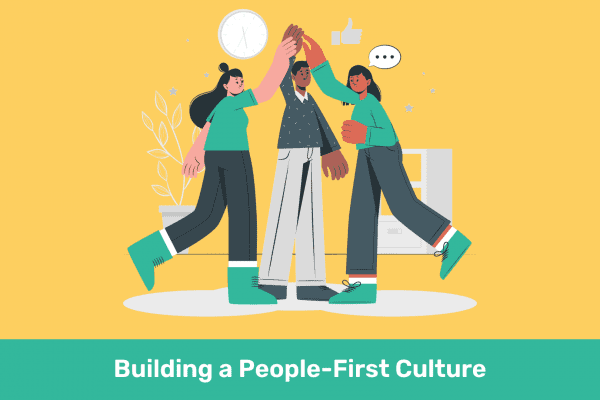Introduction
A high performance culture is the heartbeat of every successful company. It transforms the workplace into a hub where excellence is the norm, innovation flourishes, and each team member is committed to driving the company forward.
In today’s business environment, a high performance culture is the cornerstone of companies that lead the pack. These organizations don’t just meet their targets; they consistently exceed expectations and set new industry standards.
Research by McKinsey underscores the importance of this approach: companies with strong cultures see up to three times higher total returns to shareholders. This finding demonstrates the tangible impact a high performance culture can have on a company’s success. Let’s explore the strategies that help create such a powerful and positive workplace dynamic.
Defining High Performance Culture

Explanation of the Term ‘High Performance Culture’:
A high performance culture represents an organizational ethos where excellence is not just expected but deeply embedded in the very fabric of the workplace. It’s a culture that prioritizes exceptional performance, where the goals are not just to meet benchmarks but to exceed them. This concept extends beyond traditional measures of success like profits or sales; it encapsulates a mindset of continuous improvement, agility, and exceptional quality in all aspects of the business.
Key Characteristics of a High Performance Culture:
-
- Commitment to Excellence: In these cultures, there’s a pervasive attitude of striving for the best. Every task, no matter how small, is approached with a dedication to excellence.
- Goal-Oriented Approach: Targets and objectives are clear, ambitious, and aligned with the company’s vision. Employees understand their roles in achieving these goals.
- Employee Empowerment: Employees are given the autonomy to make decisions and take actions that align with company goals, encouraging a sense of ownership and responsibility.
- Open and Effective Communication: There is a strong emphasis on clear, transparent communication at all levels, fostering trust and clarity.
- Agility and Adaptability: High performance cultures are nimble, adjusting swiftly to market changes and internal challenges.
- Continuous Learning and Development: These cultures invest in developing their talent, understanding that skill enhancement contributes to overall performance.
- Collaboration and Teamwork: While individual performance is important, there is also a strong focus on teamwork and collaborative effort.
- Recognition and Reward: Achievements are recognized and celebrated, reinforcing high performance and motivating employees.
Understanding these key aspects of a high performance culture is the first step in cultivating such an environment within your organization.
Leadership’s Role in Cultivating High Performance

The Impact of Leadership Styles on Culture:
Leadership is the driving force behind the cultivation of a high performance culture. The style and approach of leaders set the tone for the entire organization. Transformational leadership, which inspires and motivates employees towards a collective vision, is particularly effective in fostering high performance. Leaders who demonstrate a commitment to excellence, encourage innovation, and show genuine concern for their team’s development and well-being, inherently cultivate an environment where high performance is the norm.
Also Read: 5-Levels of Leadership
Strategies for Leaders to Foster a High-Performance Environment:
-
- Lead by Example: Leaders should embody the qualities they wish to see in their team. Demonstrating commitment, resilience, and a high work ethic encourages similar behaviors among employees.
- Clear Vision and Communication: Articulate a clear and compelling company vision. Ensure that communication is transparent and that organizational goals are well understood and embraced by all team members.
- Empower and Trust Your Team: Give employees autonomy and trust them with responsibilities. Empowering staff to make decisions enhances their engagement and commitment to the organization’s goals.
- Foster a Growth Mindset: Encourage continuous learning and development. This can be achieved through training programs, workshops, and creating an environment where feedback is constructive and regular.
- Create a Safe Environment for Risk-Taking: Encourage innovation by allowing room for calculated risks and viewing failures as learning opportunities rather than setbacks.
- Recognize and Reward High Performance: Regularly acknowledge and reward employees who demonstrate exceptional work. Recognition can be monetary, but it can also be in the form of public acknowledgment, opportunities for growth, or additional responsibilities.
- Build a Collaborative Culture: Promote teamwork and collaboration. Encourage leaders at all levels to work cross-functionally and break down silos.
- Regular Feedback and Performance Reviews: Conduct regular performance reviews not just to evaluate, but also to plan future goals, discuss career progression, and address any concerns.
Effective leadership is critical in shaping a high performance culture. Leaders who actively engage in these strategies not only inspire their teams to excel but also create an environment where high performance is continuously nurtured and celebrated.
Setting Clear and Ambitious Goals

Importance of Goal Setting in Driving Performance:
Goal setting is fundamental in steering a high performance culture. Clear and ambitious goals provide direction and a sense of purpose, driving employees to focus their efforts on key outcomes. Well-defined goals act as benchmarks for success, motivating teams and individuals to push beyond their comfort zones. They also facilitate better alignment of individual objectives with the overarching goals of the organization, ensuring that everyone is working towards a common purpose.
Tips for Creating Effective, Measurable, and Challenging Goals:
-
- Align Goals with Organizational Vision: Ensure that the goals set for teams and individuals are in harmony with the broader vision and mission of the company. This alignment helps in fostering a sense of purpose and belonging.
- Utilize the SMART Criteria: Goals should be Specific, Measurable, Achievable, Relevant, and Time-bound. This framework ensures clarity and feasibility, making it easier to track and accomplish them.
- Involve Employees in the Goal-Setting Process: Engaging employees in setting their goals can increase their commitment and motivation. It helps them understand the relevance of their work and its impact on the organization.
- Set Challenging yet Attainable Goals: While goals should be ambitious to stimulate performance, they also need to be realistic to avoid frustration and burnout. Finding this balance is key.
- Regularly Review and Adjust Goals: As business conditions change, goals may need to be revisited and adjusted. Regular reviews ensure that goals remain relevant and challenging.
- Provide the Necessary Resources and Support: Ensure that employees have the resources, training, and support needed to achieve their goals. This might include access to technology, training programs, or mentorship.
- Celebrate Achievements: Recognizing and celebrating when goals are met can greatly boost morale and motivation. It also sets the stage for setting new, more challenging goals.
Effective goal setting acts as a roadmap guiding employees towards excellence and is a crucial component of a high performance culture. By setting and managing goals thoughtfully, leaders can significantly enhance overall organizational performance.
Encouraging Employee Engagement and Participation

Role of Employee Engagement in High Performance:
Employee engagement is a critical determinant of high performance in the workplace. Engaged employees are more motivated, committed, and willing to go the extra mile for their organization. They are typically more aligned with the company’s goals and are proactive in seeking solutions and opportunities for improvement. High levels of engagement lead to better job satisfaction, reduced turnover, and significantly higher productivity and performance. In essence, when employees are engaged, they are fully invested in their work and the success of the company.
Methods to Increase Engagement and Encourage Input:
-
- Foster Open Communication: Create an environment where open dialogue is encouraged. This includes having regular team meetings, one-on-one check-ins, and platforms where employees can freely share ideas and feedback.
- Provide Growth and Development Opportunities: Employees are more engaged when they see opportunities for personal and professional growth. Offer training programs, workshops, mentorship, and clear pathways for career advancement.
- Empower Employees: Give employees autonomy in their work and the opportunity to make decisions. This empowerment makes them feel valued and invested in the outcomes of their projects.
- Acknowledge and Value Contributions: Regularly recognize and appreciate the efforts and achievements of employees. Recognition can be formal, like awards and bonuses, or informal, like verbal praise or a thank-you note.
- Create a Positive Work Environment: A supportive and collaborative atmosphere contributes significantly to employee engagement. Encourage teamwork, celebrate successes together, and address conflicts promptly and constructively.
- Involve Employees in Decision Making: Involve your team in decisions, especially those that affect their work and the overall organization. This inclusion helps them feel more connected and influential.
- Conduct Regular Surveys: Utilize surveys to understand employee needs, opinions, and levels of satisfaction. This data can guide changes and improvements in the workplace.
- Promote Work-Life Balance: Encourage a balance between professional and personal life. Flexible work arrangements, reasonable workloads, and support for personal commitments can increase engagement.
By implementing these methods, organizations can create an environment where employees feel engaged and motivated, contributing to a culture of high performance.
Fostering a Growth Mindset and Continuous Learning

Growth Mindset vs. Fixed Mindset:
The concept of a growth mindset versus a fixed mindset, popularized by psychologist Carol Dweck, is pivotal in understanding how people perceive their abilities and potential. A fixed mindset assumes that our intelligence, talents, and abilities are static traits that we can’t change in any meaningful way. In contrast, a growth mindset thrives on challenge and sees failure not as evidence of unintelligence but as a heartening springboard for growth and for stretching our existing abilities.
In a high performance culture, fostering a growth mindset is key. This mindset leads to a love of learning and resilience, which are essential for great accomplishment. Conversely, a fixed mindset can hinder performance as it creates an aversion to failure, discouraging risk-taking and innovation.
Encouraging Learning and Development Opportunities:
-
- Promote Learning as an Ongoing Process: Establish continuous learning as a core organizational value. Encourage employees to view skills and knowledge development as an ongoing journey rather than a destination.
- Provide Diverse Learning Resources: Offer access to various learning opportunities, such as online courses, workshops, seminars, mentoring programs, and cross-training experiences.
- Encourage a Culture of Feedback: Constructive feedback is vital for growth. Create an environment where regular, constructive feedback is given and received positively, focusing on growth and improvement.
- Celebrate Efforts and Resilience: Recognize and reward not just achievements but also the effort and resilience shown in the face of challenges. This reinforces the value of persistence and learning from setbacks.
- Lead by Example: Leadership should model a growth mindset by showing their own commitment to personal and professional development. Leaders can share their learning experiences and demonstrate openness to new ideas and approaches.
- Create Opportunities for Stretch Assignments: Encourage employees to take on new, challenging projects outside their comfort zones. These assignments can drive growth and skill development.
- Foster a Safe Environment for Learning: Create a workplace where making mistakes is acceptable as part of the learning process. This means moving away from a culture that punishes errors to one that sees them as opportunities for growth.
By fostering a growth mindset and supporting continuous learning, organizations cultivate an environment where employees are motivated to expand their horizons, innovate, and contribute to the organization’s success.
Building a Culture of Accountability

Importance of Accountability in High Performance:
Accountability is a cornerstone of high performance in any organization. It involves taking responsibility for one’s actions and results, both individually and in teams. In a culture of accountability, employees are committed to achieving results and understand how their actions impact the overall success of the organization. This commitment to accountability drives higher levels of performance, as team members consistently meet or exceed expectations, and problems are addressed proactively rather than avoided.
Strategies to Encourage Personal and Team Accountability:
-
- Set Clear Expectations: Clearly define roles, responsibilities, and expectations for each team member. Everyone should understand what they are accountable for and how their performance impacts the wider goals of the organization.
- Provide the Necessary Tools and Resources: Ensure that employees have the resources, training, and support they need to meet their responsibilities effectively.
- Foster Open Communication: Encourage a culture where employees feel comfortable discussing challenges and seeking help. Regular check-ins and open-door policies can facilitate this.
- Implement Effective Goal-Setting: Use specific, measurable, achievable, relevant, and time-bound (SMART) goals to provide a clear roadmap for what needs to be accomplished.
- Encourage Ownership: Empower employees to take charge of their tasks and decisions. This ownership inspires a deeper commitment to their work and its outcomes.
- Promote Transparency and Visibility: Make progress and results visible. This can be through regular team meetings, performance dashboards, or progress reports.
- Hold Regular Accountability Meetings: Regularly review progress towards goals in team meetings, focusing on results and learning from outcomes, not just on tasks completed.
- Constructive Feedback and Consequences: Provide constructive feedback. When expectations are not met, address the issue promptly and fairly, focusing on the situation, not the person.
- Celebrate Achievements: Recognize and reward employees when they meet their goals and demonstrate accountability. This reinforces positive behavior and sets a standard for others.
Building a culture of accountability is essential for high performance. It creates an environment where employees are dedicated to their responsibilities, understand the importance of their contribution, and are committed to achieving the organization’s objectives.
Recognizing and Rewarding High Performance

Impact of Recognition on Motivation and Performance:
Recognition is a powerful tool in any high performance culture. It validates the effort and achievements of employees, boosting their motivation and engagement. When employees feel recognized, they are more likely to be productive and committed to their work, driving overall performance. Recognition goes beyond just boosting morale; it reinforces the behaviors and outcomes that lead to success and sets a standard for excellence in the organization.
Ideas for Effective Recognition and Reward Systems:
-
- Timely and Specific Praise: Recognize and praise achievements soon after they occur. Be specific about what the employee did well and how it impacts the organization.
- Performance-Based Bonuses: Offer financial rewards for meeting or exceeding performance targets. This could be in the form of bonuses, raises, or profit sharing.
- Employee of the Month/Quarter/Year Awards: Implement a regular award program that recognizes outstanding contributions. Consider including peer nominations in this process.
- Public Recognition: Acknowledge achievements in team meetings, company newsletters, or on corporate social media. Public recognition can significantly boost an employee’s sense of achievement.
- Professional Development Opportunities: Reward high-performing employees with opportunities for further training and development. This could include workshops, courses, conferences, or even further education.
- Additional Time Off: Offer extra vacation days or flexible working arrangements as a reward for excellent performance.
- Customized Rewards: Tailor rewards to individual preferences. Some employees might prefer public recognition, while others might appreciate a private thank you note or a small gift.
- Career Advancement Opportunities: Provide opportunities for high performers to take on more challenging roles or responsibilities. This can be more rewarding than monetary incentives for some employees.
- Celebrate Milestones: Mark significant achievements, project completions, or anniversaries with celebrations or acknowledgments.
By effectively recognizing and rewarding high performance, organizations not only motivate their employees but also cement a culture of excellence and continuous improvement.
Ensuring Consistent Communication and Feedback

Role of Communication in Maintaining High Performance:
Effective communication is the lifeblood of a high performance culture. It ensures that everyone is aligned with the company’s goals and aware of their roles and responsibilities. Clear and open communication fosters a sense of trust and transparency within the organization, enabling employees to understand the big picture and how their work fits into it. In high-performing environments, communication is two-way; it’s not just about disseminating information from the top down, but also about listening to feedback from all levels of the organization.
Establishing Regular Feedback Channels:
-
- Regular One-on-One Meetings: Schedule consistent one-on-one meetings with team members to discuss progress, address concerns, and provide personalized feedback.
- Performance Reviews: Conduct regular performance reviews to discuss achievements, challenges, and areas for development. Make these reviews constructive and forward-looking.
- Feedback Tools and Surveys: Implement tools or surveys to collect feedback about various aspects of the workplace, including management effectiveness, job satisfaction, and company culture.
- Open-door Policy: Encourage an open-door policy where employees feel comfortable approaching leadership with ideas, concerns, or feedback.
- Team Meetings and Discussions: Use regular team meetings as an opportunity for members to share updates, offer insights, and give peer feedback.
- Training in Communication Skills: Offer training to both managers and employees to improve their communication skills, particularly in giving and receiving feedback effectively.
- Utilize Technology for Communication: Leverage technology platforms for regular communication and feedback. This can include intranets, communication apps, or collaboration tools.
- Feedback as Part of Company Culture: Emphasize the importance of feedback in the organization’s culture. Recognize and reward those who constructively provide and act on feedback.
By maintaining consistent and effective communication and establishing regular feedback channels, an organization can ensure that all team members stay engaged, informed, and aligned with the company’s objectives and culture.
Adapting to Change and Overcoming Challenges

Importance of Adaptability in High-Performance Cultures:
Adaptability is a crucial trait in high-performance cultures, especially in today’s fast-paced business environment. Organizations that can quickly pivot in response to changes and challenges are more likely to thrive. Adaptability involves being open to new ideas, willing to change course when necessary, and able to respond effectively to unexpected situations. In high-performance cultures, this flexibility is not just limited to business strategies but also extends to the mindset of every employee. It’s about fostering a culture where change is seen as an opportunity for growth and innovation rather than a threat.
Strategies for Resilience and Dealing with Setbacks:
-
- Foster a Positive Attitude Towards Change: Cultivate a culture that views change as an opportunity rather than an obstacle. Encourage a positive outlook where change is associated with growth and learning.
- Encourage Agile Thinking: Develop an agile mindset across the organization. This includes embracing experimentation, being open to new approaches, and learning from both successes and failures.
- Build Resilience through Training: Offer training programs focused on building resilience. These could include stress management, adaptability skills, and creative problem-solving.
- Effective Risk Management: Encourage a proactive approach to identifying and managing risks. Regularly review and update strategies to mitigate potential challenges.
- Transparent Communication During Change: Keep lines of communication open during times of change. Provide clear, honest updates about what the changes entail and how they impact the team.
- Support Systems: Establish support systems where employees can express concerns and get support during transitions. This could include peer support groups, mentoring, or counseling services.
- Learn from Setbacks: Create a culture where setbacks are seen as learning opportunities. Conduct post-mortem analyses of projects not just to understand what went wrong, but also to glean insights for future endeavors.
- Empower Employees to Make Decisions: Give employees the autonomy to make decisions in their areas of work. This empowerment helps them to respond more swiftly and effectively to changing conditions.
By embracing adaptability and resilience, organizations in high-performance cultures can navigate change more effectively and maintain their momentum even in the face of challenges and setbacks.
Conclusion
Creating a high performance culture is an intricate process that demands focus, adaptability, and a commitment to continuous improvement. The journey begins with defining what high performance means for your organization, ensuring that the leadership exemplifies and fosters this culture. Setting clear, ambitious goals gives direction, while nurturing employee engagement and participation ensures that everyone is on board and contributing their best.
A growth mindset and continuous learning are essential for keeping the team agile and forward-thinking. Building a culture of accountability ensures that everyone is responsible for their part in the collective success. Recognizing and rewarding high performance not only motivates employees but also reinforces the behaviors and outcomes critical for success. Communication and regular feedback keep everyone aligned and informed, adapting swiftly and effectively to change and challenges ensures resilience in an ever-evolving business landscape.
Implementing these practices can transform the dynamics of your organization, setting the stage for remarkable achievements and sustainable success. For companies looking to streamline this process, tools like Woliba can be invaluable. Offering resources for recognition, wellness, and rewards management, Woliba provides an integrated solution to help build and maintain a thriving company culture that aligns with the principles of high performance.
Remember, cultivating a high performance culture is a dynamic and ongoing process. It’s about building an environment where excellence is not just expected, but enthusiastically pursued. With commitment and the right tools, any organization can embark on this transformative journey towards operational excellence and enhanced employee well-being.




